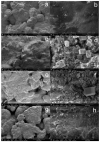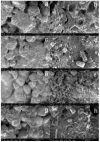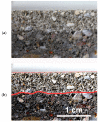Fluorocarbosilane-Based Protective Coatings for Concrete
- PMID: 36079380
- PMCID: PMC9457494
- DOI: 10.3390/ma15175994
Fluorocarbosilane-Based Protective Coatings for Concrete
Abstract
The effectiveness of protective coatings based on 3-(2,2,3,3,4,4,5,5-octafluoropentyloxy)propyltriethoxysilane (OFTES) in protecting concrete surfaces against water was tested. For the synthesis of OFTES, 2,2,3,3,4,4,5,5-octafluoropentanol, which is a by-product in the synthesis of poly(tetrafluoroethylene), was used. The proposed silane is a cheaper alternative to the fluorinated organosilicon compounds currently used. The coatings were deposited by the sol-gel method. As a result of the creation of chemical bonds between the concrete surface and the silane, a coating was created that permanently increases the hydrophobicity of the concrete. Fluorine chains attached to silicon atoms are an effective barrier that prevents access to water and limits its impact on the concrete surface. As a result of the proposed silanization, the concrete surface obtained a hydrophobic character at contact angles of up to 126°, and the water absorption of the concrete decreased by up to 96%.
Keywords: concrete; fluorocarbosilane; organically modified silanes; protective; sol-gel processes.
Conflict of interest statement
The authors declare no conflict of interest.
Figures








References
-
- Dhir R.K., Hewlett P.C., Chan Y.N. Near-surface characteristics of concrete: Assessment and development of in situ test methods. Mag. Concr. Res. 1987;32:183–195. doi: 10.1680/macr.1987.39.141.183. - DOI
-
- Song H., Lee C., Ann K.Y. Factors influencing chloride transport in concrete structures exposed to marine environments. Cement Concr. Compos. 2008;30:113–121. doi: 10.1016/j.cemconcomp.2007.09.005. - DOI
-
- Meyer A. Importance of the surface layer for the durability of concrete structures. ACI Spec. Publ. 1987;100:49–62.
-
- Basheer P., Basheer L., Cleland D.J., Long A.E. Surface treatments for concrete: Assessment methods and reported performance. Constr. Build. Mater. 1997;11:413–429. doi: 10.1016/S0950-0618(97)00019-6. - DOI
-
- British Standard Institution; London, UK: 1998. Products and Systems for the Protection and Repair of Concrete Structures. Definitions, Requirements, Quality Control, and Conformity Assessment. Part 2: Concrete Surface Protection Systems.
LinkOut - more resources
Full Text Sources
Research Materials

